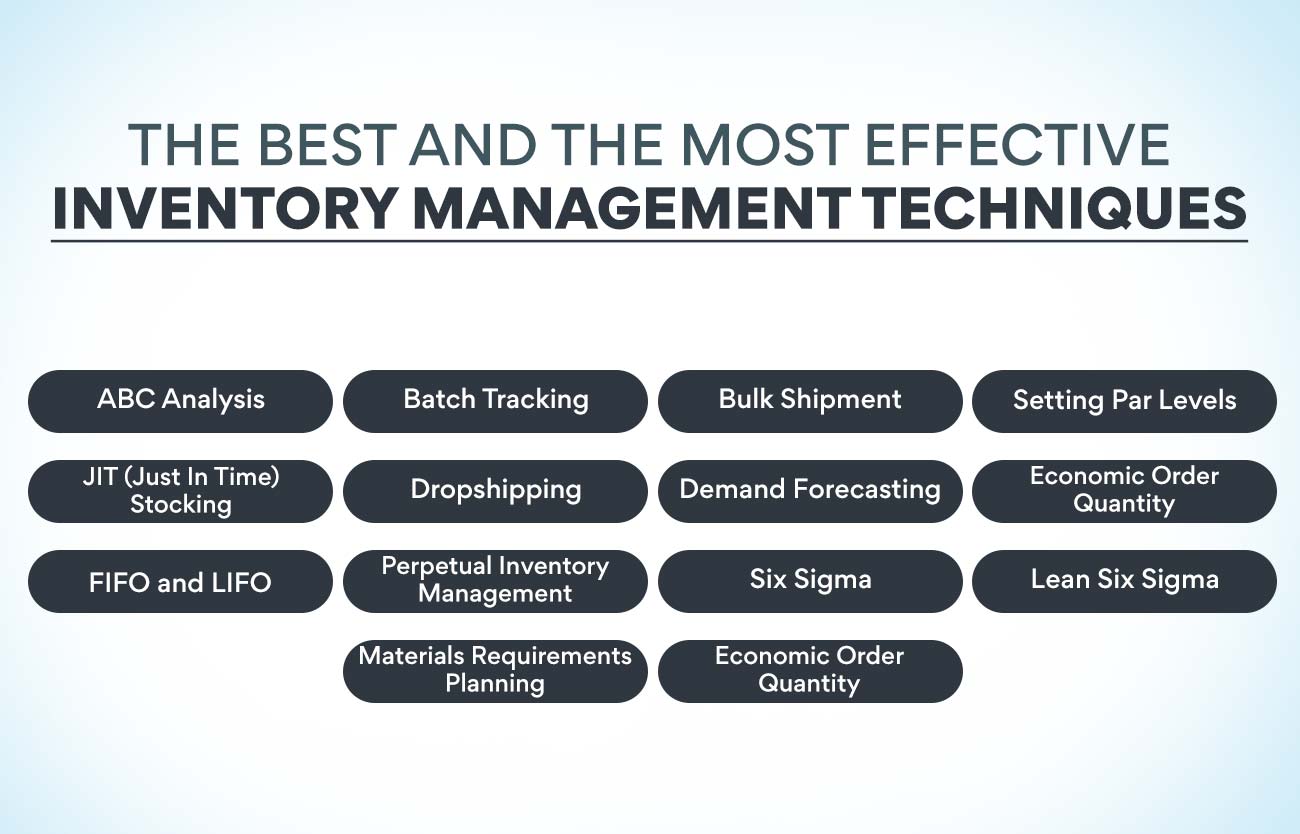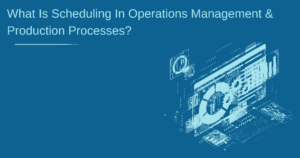Inventory management might seem daunting, but it doesn’t have to be. With the right tools and techniques in place, you can streamline your inventory management process and make it work for you. In this blog post, we will explore 15 effective inventory management techniques. These techniques will help you keep up with your inventory and ensure you always have the products you need.
What is Inventory Management, And What Are Its Benefits?
Inventory management tracks and manages stock levels to ensure businesses can meet customer demand. Inventory management is the proactive process of controlling stock levels to ensure that businesses can meet customer demand. By keeping track of stock levels, companies can avoid the cost and disruption associated with overstocking or understocking.
Several benefits can be gained from effective inventory management, including:

Increased Sales: Better inventory management will always help keep your stock updated. If customers know that a business always has the products they need in stock, they are more likely to make purchases from them rather than going to a competitor.
Improved Customer Service: Having the right products in stock helps businesses meet customer demand and improves satisfaction levels. It is crucial for businesses that rely on repeat customers or word-of-mouth marketing. By having the right inventory level, companies can avoid situations where they cannot meet customer demand. This can lead to improved customer satisfaction and loyalty.
Increased efficiency: Efficient inventory management can help businesses reduce waste and increase productivity. When inventory is managed effectively, businesses can avoid issues such as lost sales due to out-of-stock items or disruptions to production due to missing supplies.
Reduced risk: Carefully managing inventory helps businesses reduce the risk of losses due to obsolescence or damage. Companies can minimize the impact of unexpected events, such as supplier shortages or natural disasters, by knowing what products are in stock and where they are located.
Do you see yourself as a brilliant inventory manager who can single-handedly manage everything and relish the benefits of inventory management? Our course is the best place to start with. Check out our Advanced Certificate in Operations, Supply Chain and Project Management to know more.
Inventory VS Stock: What’s The Difference?
Inventory and stock are both terms used in the business world, but they have different meanings. Inventory refers to the raw materials and finished products that a company has in hand, while stock relates to the shares of a company that investors own.
There are a few critical differences between inventory and stock:
- Inventory is physical, while stock is financial.
- Inventory is used in production, while stock is not.
- Inventory can be bought and sold, while stock cannot.
- Changes in inventory levels can affect a company’s stock price.
How Do Better Inventory Management Techniques Improve Supply Chain?
To maintain efficient inventory management, businesses need to understand how to streamline their supply chain. Many techniques can be used to achieve this goal, but some are more effective than others.
One popular method is known as the “just in time” technique. It only involves ordering inventory as needed, which cuts down on waste and storage costs. Another common approach is the “economy of scale” method, which takes advantage of discounts for buying larger quantities of inventory at once.
Both of these methods can improve your bottom line by reducing inventory costs. In addition, they can also help to ensure that you have the products you need on hand when your customers want them, which can improve customer satisfaction levels.
The Best And The Most Effective Inventory Management Techniques
Many different inventory management techniques can be used to keep track of inventory and ensure it is used effectively. Some of the most popular and effective techniques include:

ABC Analysis
ABC analysis is a method of inventory management that categorizes inventory based on importance. Items considered “A” items are the most important and are given the highest priority when it comes to stocking, while “C” items are the least important and are given less attention.
This technique is used to help organizations focus their resources on the essential items in their inventory. Doing so can improve their overall inventory management and better utilize their resources.
There are many different ways to categorize inventory, but ABC analysis is one of the most popular and effective methods. This technique can be adapted to any organization and any inventory.
Batch Tracking
Batch tracking keeps track of inventory levels for each product in a batch. This information determines when products need replenishment and can help avoid stockouts.
Batch tracking can be done manually or using the software. When done manually, it is often done using spreadsheets. It can be time-consuming and error-prone. Software such as InventoryIQ can automate batch tracking and make it easier to manage inventory levels.
Software like InventoryIQ can also provide other features, such as alerts when products are running low, the ability to create purchase orders, and more. It can make inventory management more accessible and help businesses save time and money.
Also Read: How To Become A Better Product Manager: Top 10 Tips
Bulk Shipment
To manage inventory effectively, businesses need to have a clear understanding of their overall stock levels. They need to know how much inventory they have on hand at any given time and how much inventory they need to keep to meet customer demand.
One way to keep track of inventory levels is through a bulk shipment system. This information is then used to determine when new shipments need to be ordered and how much inventory must be kept on hand. Bulk shipment systems allow businesses to track their inventory levels in real time so they can always be sure of what they have on hand.
Bulk shipment systems can be very beneficial for businesses, as they can help to reduce the amount of time and money spent on managing inventory. Additionally, bulk shipment systems can help companies to avoid stockouts and other issues that can disrupt operations.
Setting Par Levels
Inventory management is all about keeping track of the items in your stock, and setting par levels is a key part. Par levels are the minimum or maximum amount of a thing you should have on hand at any given time. Setting par levels helps you to avoid running out of items or having too much inventory and tying up valuable resources.
There are a few different ways to set par levels. One standard method is to base it on historical data, such as sales data or usage patterns. Another approach is to use industry benchmarks or standards other businesses in your field set. Whichever method you choose, it’s essential to review your par levels regularly and adjust as needed.
Technology can also help with setting and managing par levels. Inventory management software can give you real-time visibility into your inventory levels, so you can quickly identify when items need to be replenished. This will save you time and money by helping you avoid stockouts and overages.
JIT (Just In Time) Stocking
JIT stocking is a type of inventory management technique that involves stocking only the items needed when needed. This can help to reduce inventory costs and improve inventory turnover. It also helps to avoid excess inventory, which can tie up capital and lead to storage costs.
The goal of JIT stocking is to have the right items in stock, at the right time, in the correct quantity. This can be achieved by using methods such as kanban or just-in-time production.
JIT stocking can help reduce inventory costs because it minimizes the amount of money tied up in inventory. It can also improve inventory turnover because items are only sitting on shelves for a short time.
To implement JIT stocking, businesses need to understand their customer demand and production process well. They also need to have a system in place to track stock levels and replenish items as needed.
Also Read: What Are The Stages And Examples Of A Product Lifecycle?
Dropshipping
Inventory management is key to any successful business, but what is it, and how do you do it effectively?
Inventory management is the process of tracking and managing inventory levels, orders, and stock. It’s a critical part of running a business, as it helps you avoid overstocking or running out of products.
There are several different techniques you can use to manage your inventory effectively. Here are a few of the most popular:
Demand Forecasting
To have an effective inventory management system, businesses need to forecast future demand for their products or services. This helps them determine how much inventory they need to keep on hand to meet customer demand.
There are a variety of methods that businesses can use to forecast demand, such as trend analysis and regression analysis. The best way to forecasting demand will vary depending on the type of business and the products or services they offer.
An essential part of effective inventory management is setting accurate safety stock levels. Safety stock is the extra inventory that a business keeps on hand in case of unexpected spikes in customer demand. If a business needs more safety stock, it may run into stockouts, leading to lost sales and unhappy customers.
If you’re looking to improve your inventory management, consider implementing some effective demand forecasting techniques. By accurately predicting customer demand, you can ensure that you have the right amount of inventory on hand at all times.
Economic Order Quantity
Inventory management is the process of ensuring that businesses have the right inventory levels to meet customer demand. The goal of inventory management is to minimize the cost of holding inventory while maximizing the company’s profits.
One key concept in inventory management is economic order quantity (EOQ). EOQ is the order quantity that minimizes the total cost of ordering and holding inventory. To calculate EOQ, businesses need to know their annual demand, ordering costs, and carrying costs.
EOQ can be a helpful tool for managing inventory, but it’s important to remember that there is no single perfect order quantity for all businesses. The best order quantity for your business will depend on factors like your product mix, sales volume, lead time, and more.
FIFO and LIFO
Inventory management is vital to businesses because it can help them keep track of their stock, ensure that items are being sold at the right price, and prevent losses due to out-of-date or damaged merchandise.
There are two main methods of inventory management: first in, first out (FIFO) and last in, first out (LIFO). FIFO means that the first items to arrive in inventory will be the first ones sold. LIFO, on the other hand, means that the last items to arrive in inventory will be the first ones sold.
Businesses usually choose one method or the other based on what makes more financial sense for their products. For example, if a company deals with perishable goods, it would likely use FIFO to sell older items before they go bad. On the other hand, if a company deals with seasonal goods, they might use LIFO to sell their newest merchandise before it goes out of style.
No matter which method a business chooses, effective inventory management is essential to keeping track of stock levels and ensuring that products are being sold at the right price.
Perpetual Inventory Management
Perpetual inventory management involves continuously tracking and updating information on inventory levels. This information can be used to make decisions about when to order new products and how much stock to keep on hand.
Perpetual inventory management can be a very effective way to manage inventory, but it does require a significant investment of time and resources. Businesses need to weigh the benefits of perpetual inventory management against the costs before deciding if it is the right approach for them.
Six Sigma
Inventory management is the process of ensuring that a company has enough inventory to meet customer demand while also keeping costs low. Six Sigma is a popular technique that can be used to improve inventory management.
Six Sigma is a data-driven approach that seeks to improve quality by eliminating defects. In inventory management, Six Sigma can be used to streamline processes and reduce waste. For example, Six Sigma can be used to identify errors in the ordering process so that orders are placed more accurately and on time. Additionally, Six Sigma can be used to reduce the amount of inventory kept on hand, which can save money on storage costs.
When appropriately applied, Six Sigma can be an effective tool for improving inventory management. However, it is essential to note that Six Sigma is just one technique that can be used to improve quality; many other approaches may also be appropriate for your company.
Lean Six Sigma
Inventory management is the process of tracking and managing inventory levels, orders, and stock to ensure that businesses have the right products in the right quantities at the right time.
Lean Six Sigma is a methodology that uses a data-driven approach to identify and eliminate waste in all aspects of a business, including inventory management. Lean Six Sigma aims to streamline processes and reduce costs while ensuring quality control.
When it comes to inventory management, Lean Six Sigma can be used to streamline processes, reduce waste, and improve accuracy. For example, by using data to track inventory levels, businesses can avoid overordering or stocking too few products. In addition, by mapping out processes and identifying where bottlenecks occur, companies can make changes to improve efficiency. Finally, by implementing quality control measures such as regular audits, businesses can ensure that their inventory management practices are up to par.
Overall, Lean Six Sigma is an effective way to improve inventory management practices and reduce costs. Businesses can streamline their operations and avoid waste by using data to drive decision-making.
Materials Requirements Planning
Many different techniques can be used to manage inventory effectively, but one of the most important is materials requirements planning (MRP).
Materials requirements planning is a system that helps companies plan for the materials they need to produce their products. It considers the amount of each material needed, when it will be needed, and how long it will take to procure the material. This information is then used to create a production schedule that ensures everything necessary is available when it’s needed.
MRP can be complex, but it is essential for effective inventory management. By considering all of the variables involved in production, MRP can help companies avoid stockouts, shortages, and other issues that can disrupt operations.
Economic Order Quantity
Inventory management is the process of organizing, storing, and tracking inventory. In business, inventory refers to the goods and materials that are used to produce finished products.
The goal of inventory management is to ensure that the right amount of inventory is available at the right time. This can help businesses avoid stockouts, which can lead to lost sales, and excess inventory, which can tie up working capital.
To calculate EOQ, businesses need to know the following information:
- The demand for the product (D)
- The ordering cost per unit (C)
- The holding cost per unit (h)
There are several different techniques that businesses can use to manage their inventory. One common technique is called economic order quantity (EOQ).
EOQ is a formula that helps businesses determine how much inventory they should order at one time. The goal of EOQ is to minimize the total cost of ordering and storing inventory.
How To Select The Best Inventory Management Technique?
There are a few key factors to keep in mind when selecting the best inventory management technique for your business. The first is to consider the size and scale of your operation. A simple spreadsheet or pen-and-paper system may be sufficient if you have a small business with limited inventory. However, if you have a larger operation with more complex inventory needs, then you’ll need to consider investing in a more sophisticated inventory management system.
The second factor to consider is the type of products you sell. A simple spreadsheet or pen-and-paper system may be sufficient if you sell physical goods that need to be tracked and managed manually. However, if you sell digital goods or services that can be delivered electronically, then you’ll need to consider investing in an automated inventory management system.
The third factor to consider is the frequency of your inventory turnover. If you have a high turnover rate, then you’ll need to consider investing in an automated inventory management system that can keep up with the pace of your business. However, a simple spreadsheet or pen-and-paper system may be sufficient if you have a low turnover rate.
The fourth and final factor to consider is your budget. There are many different kinds of inventory management systems on the market, ranging from free and open-source options to expensive enterprise solutions. You’ll need to decide how much you’re willing to spend on an inventory management system based on the size and scale of your operation,
Conclusion
Inventory management is a critical part of any business, as it ensures that you have the right products on hand to meet customer demand. You can minimize stockouts, reduce waste, and improve your overall profitability by implementing effective inventory management techniques. The list of 15 effective inventory management techniques will give you ideas on how to improve your practices. If you need help getting started as a supply chain manager, check out our insightful and engaging course Advanced Certificate in Operations, Supply Chain and Project Management. Its detailed curriculum gives you end-to-end supply chain and project management support. With our certificate course, you will get enough flexibility to kickstart your career without compromising on your current commitments. This course is ideal for building industry domain expertise by gaining theoretical and practical knowledge.
Want to discover more about our course? Check out our course detail page now.
More Information:
What Are General Management Courses?
Roles and Functions of Operations Management



























